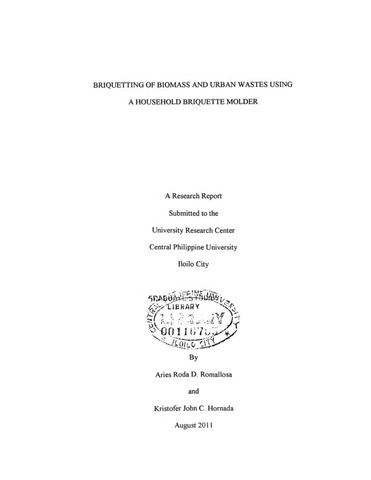Briquetting of biomass and urban wastes using a household briquette molder
Résumé
This study was conducted to produce briquettes as an alternative source of energy from abundant biomass and urban wastes using a locally fabricated household briquette molder which is composed of molders, handle, and frame. The mixtures used were the following: Briquette 1: paper (100%); Briquette 2: CRH (71%) + cornstarch (29%); Briquette 3: Sawdust (71%) + cornstarch (29%); Briquette 4: paper (50%) + CRH (50%); Briquette 5: paper (50%) + sawdust (50%); and Briquette 6: paper (50%) + CRH (25%) + sawdust (25%). Smaller sizes of balled homogeneous materials were placed on each of the molders of the machine. The materials were compacted by closing and pressing down the movable upper half portion of the molder then the briquettes produced were placed on trays for sun-drying until ideal for fuel use. Briquettes 1 (Paper), 5 (Paper + Sawdust), and 6 (Paper + CRH + Sawdust) were found to be the most viable mixtures and are therefore recommended for the production of briquettes. This is based on the practicality of production requirements and high production rate, better quality of fuel produced, fast operating performance in terms of boiling water and cooking rice, and potential earnings that may be gained when adopted as an income-generating project.
Description
Abstract only
Associated Content
Full paper published in PatubasSuggested Citation
Romallosa, A. R. D. & Hornada, K. J. C. ( 2011). Briquetting of biomass and urban wastes using a household briquette molder (Research report). Jaro, Iloilo City: University Research Center, Central Philippine University.
Type
Technical ReportSujet
Shelf Location
GSL 630.72 R661
Physical Description
vii, 39 leaves: illustrations
Collections
- Research reports [167]
- Research reports [37]


